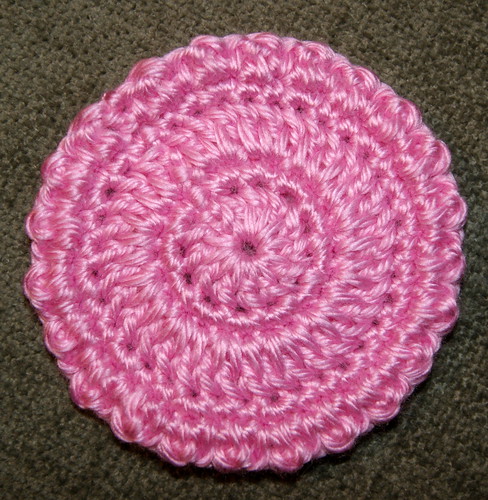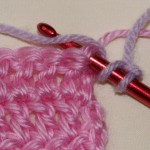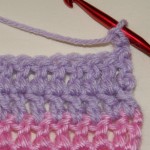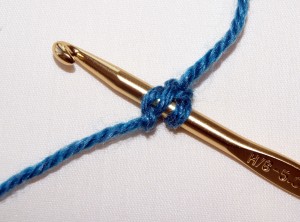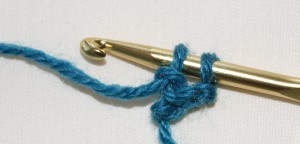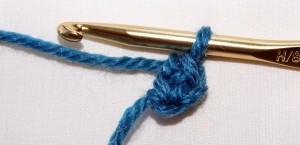Tag Archive | Crochet
Crochet Designing Tips – Working in the Round
When designing a crochet project that will end up being a circle or needing a round bottom (“working in the round”), there are a few simple guidelines to follow so you don’t end up with a wavy coaster or a little bowl!!
Remember, when working in the round, you must increase on each round so that your circle will lie flat. If you increase too many times, you end up with a ruffled look and if you don’t increase enough, your circle curls in on itself looking like a bowl. The wonderful crochet world has developed a “simple” guideline to help you keep your increases in proportion with the growing diameter of your circle.
The suggested beginning circle for a SC (single crochet) design would be 6 stitches. The beginning circle for a HDC (half double crochet) would be 8 stitches, for a DC (double crochet) begin with 12 stitches, and for a TR (treble crochet) it is best to begin with 18 stitches.
Once you have crocheted your beginning circle and joined with a SL (slip) stitch, place a marker so you know that is the start of your round. Now for the next increase round, you will work two stitches of your choice into every stitch that forms your circle.
Again, join with a SL stitch, move your marker and get ready for your third round. For this round, you will increase by working two stitches into every other stitch.
Repeat with your SL stitch, replace your starting point marker and begin your fourth round increases by working two stitches into every third stitch. Your fifth round increases would be working two stitches into every fourth stitch. Continue increasing in this pattern until your circle is as large and round as you want it to be.
By staggering your increases in the above fashion, the diameter of your circle will grow evenly and have a nice finished look.
Experiment with various types of yarns and different sized hooks to achieve a wide variety of crocheted circles.
Just imagine all the fun ways to use your circles — add them to clothing, make unique jewelry, update an old pillow or sweater or just use them alone as a wonderful coaster for that special cup of tea or coffee!!
- TIP: Crochet 4 CH (chain stitches), join with a SL stitch and within that circle begin your SC – 6 CH for HDC – 10 CH for DC – 12 CH for TR.
HAPPY CREATING!!
Disclaimer: This post contains affiliate links – “small commission earned”
Adding a Crocheted Edging
Crocheted edgings are another way you can personalize an article of clothing or update a home decor item. You can just about take any stitch pattern you like and use it as an edging for whatever strikes your fancy.
The most important part of doing an edging is making sure that your stitch placement guides/holes are even. There are several different types of tools available to make those holes for you so that they are spaced evenly to give a wonderful finished look. Check out the edgerydoo which looks like it does an excellent job of making small holes for you to crochet an edging along a blanket, etc. Also, the blogspot called At Home in English Valley used a Skip Stitch Rotary Blade to create small holes in a flour sack tea towel for crocheting a nice edge.
Another thing that I like to do as a foundation to crochet an edging on to is the lazy daisy or detached chain embroidery stitch. This doesn’t require making any holes and you can embroider the stitch along the edge of almost anything.
NOTE: I am left-handed so embroidery stitches are started from the opposite end of fabric from a right-handed person. However, I crochet right-handed so the single crochet stitches are going in the other direction!! That’s what happens when you are the only left-handed person in your household growing up. No one could teach me how to crochet left-handed!!
An important factor to keep in mind whether you are making holes for stitches or using an embroidery stitch for the foundation, is to plan for your stitch multiplier. A stitch multiple is the number of stitches needed to crochet a complete stitch pattern. Example: if your edging pattern calls for a multiple of 3, you need to insure that your foundation row can be divided by 3 evenly. Plus you will need to have one more hole or embroidery stitch for turning or corners if needed.
After you have your foundation row set up, I like to go around my entire foundation row crocheting a single crochet in all my stitches or holes (at this time, you can insure you have the correct number of SC for your pattern, increase in a stitch if you need to). By doing this, you have a nice base to work from. After completing your row of SC, then you are ready to begin the edging design you have chosen.
Once you start crocheting edgings onto your projects, your hook will have a mind of its own!!!
- TIP: If you are doing the lazy daisy embroidery stitch, use the same color crochet thread for the foundation row so that everything blends together.
HAPPY CREATING!!
Disclaimer: This post contains affiliate links – “small commission earned”
Changing Yarn Colors within your project
Anyways, it really, really doesn’t have to be such an ordeal no matter what process you use when it comes to changing your yarn colors. For me, this is the best way to change yarn colors and takes all those stressful thoughts and throws them away.
All I simply do is when I come to the end of the row of where the new color is to be added, I fasten off. For me, it gives me the satisfaction of knowing that my crochet stitches will not come unraveled. Now turn your work to get ready for the next row and the new color. Make a slip knot onto your crochet hook using your new color, insert your hook into the first stitch of the next row and make a single crochet (sc) stitch and continue with your pattern.
IMPORTANT NOTE: If you are working half double crochets (hdc), double crochets (dc) or treble crochets (tr), you must begin your new row adding the new color with one of these stitches to give you the correct height needed to continue your pattern. Therefore, you will make your slip knot onto your hook, yarn over once for (hdc) and (dc) and yarn over twice if continuing with a (tr) — now insert your hook into the first stitch of new row with the correct number of yarn overs and proceed to make your appropriate stitch according to your pattern.
If making a stitch that requires you to add a yarn over loop to your hook when changing colors, keep your right index finger placed securely onto the yarn over loops to hold them close to the hook, now insert your hook into the first stitch, yarn over and when you begin to pull that loop through the stitch use your thumb and index fingers of your left hand to help securely hold the loops on your hook as you begin to pull your stitches through the required number of loops to make the designated stitch.
Now you have a completed stitch and you can finish working your crochet piece according to your directions and resume holding your work as always.
- TIP: I like to take my yarn ends when possible and crochet them into my rows. I just lay the yarn ends along the top edge of the row I am currently working along and hold in place while I crochet the necessary stitches for my pattern. Trim away any yarn pieces that don’t get woven into the stitches. Time saving technique and you never see them in the finished work.
HAPPY CREATING!!
Disclaimer: This post contains affiliate links – “small commission earned”
Foundation Stitch – No Chain Stitch Necessary
The foundation stitch is another way in which you can begin your crochet project. All crochet projects start off by doing the chain stitch (ch) so that you have a base in order to complete the next row of stitches according to your pattern directions.
Doing a foundation stitch is a little different than just crocheting a long row of chain stitches. It is basically a way of doing the single crochet (sc) to form your first row of stitches. One of the main reasons I will begin a project using the foundation stitch is that it doesn’t seem to end up as tight as a long string of regular chain stitches. I find that after I have crochet for just a couple of rows, my beginning chain row actually is a little tighter than my other rows, even when I am consciously making an effort to keep my chain stitches loose.
The foundation stitch is great for any project but I find it is especially great for afghan patterns when your directions call for you to crochet 100 or more chain stitches. It is easy to count your stitches and keeps an even tension with your other rows of crochet stitches.
You just crochet the foundation stitch and count it like a regular chain stitch and when you have reached the number of stitches necessary for your project, just add a regular chain stitch (ch) for turning purposes. Then proceed with your next row according to your pattern directions.
To make a foundation chain, begin by making 2 chain stitches (ch), then insert your hook under the top 2 loops of the 2nd chain, yarn over and pull the loop through (2 loops on your hook), yarn over again and pull the loop through ONLY the top loop on your hook (still 2 loops on your hook), then yarn over and pulling through both loops on your hook (now only 1 loop left on hook). You have just completed one (1) foundation stitch.
Now, you will insert your hook through both strands of the foundation stitch that you just completed, yarn over and pull through those two strands only (2 single loops on hook), yarn over again pulling only through the top loop on hook (2 loops still on hook), yarn over and pull through both of those loops (1 loop remaining on hook). Another stitch completed. Continue in this fashion until you have made all the necessary chain stitches required for your pattern. Again, be sure to end your row making one or more regular chain stitches for turning purposes.
- TIP: Your pattern directions should tell you how many turning chains you need to complete to have the required height for the new row of stitches. For example, you will need (1) chain stitch, turn and continue with a single crochet; will need (2) turning chain stitches to continue with half-double crochet; need (3) turning chain stitches for double crochet; (4) turning chain stitches for triple crochet, etc.
Have fun with the foundation stitch because you will discover what a great stitch it is!! Be sure to click on photos to zoom in for larger image.
HAPPY CREATING!!
Disclaimer: This post contains affiliate links – “small commission earned”
